Synthesis and characterization of switchable ionic compound based on DBU,CH3OH,and CO2☆
Yuan Xie ,Richard Parnas ,Bin Liang ,Yingying Liu ,Chuandong Tao ,Houfang Lu ,*
1 College of Chemical Engineering,Sichuan University,Chengdu 610065,China
2 Institute of New Energy and Low Carbon Technology,Sichuan University,Chengdu 610065,China
3 Institute of Materials Science,Univ.of Connecticut,Storrs CT 06269-3136,USA
Keywords:DBU Switchable ionic compounds Synthesis
ABSTRACT Switchable ionic compounds have wide applications in chemical processes.A switchable ionic compound based on 1,8-diazabicyclo-[5.4.0]-undec-7-ene(DBU),CH3OH and CO2 was synthesized and characterized.DBU/CH3OH/CO2 ionic compound was prepared in the presence of excess methanol,and then the excess methanol was removed by reduced pressure distillation in CO2 atmosphere.The product yield(100%)reached the theoreticalmaximum for the first time.Its structure was identi fied by NMR,FT-IR,and XRD.The crystalproductshows 8 strong peaks in XRD at 2θ values of 16.0547°,16.4308°,16.7651°,18.8714°,19.2140°,21.9471°,22.0780°,and 25.5661°.Its decomposition onset temperature(53 °C)was af firmed by TGA,which is lower than its melting point.And its ionic switch point was measured by conductivity.
1.Introduction
Almost every chemical process uses several steps,such as reaction,extraction,separation,and puri fication.In most cases,the solvent required in a particular step is different from the one required in the next step.Therefore,the choice of solvents is very important in a consecutive process.A common practice is to remove the solvent after each step and then add a new solvent in the next step in order to match the process operation,which may increase the cost and environmentalimpactordecrease the yield[1,2].Therefore,itis interesting and meaningful to find solvents that can be used in several consecutive reaction and separation steps.The properties of such solvents must often be altered,preferably under mild conditions,to proceed from step to step.
Currently,a smart type of switchable solvent was proposed by Jessop et al.[1].The solvent properties can be reversibly changed under mild conditions by reacting with an alcohol and an acid gas.This kind of switchable solvent,mainly containing amine,amidine or guanidine,is capable of transformation from a mixture of molecular compounds to an ionic liquid at room temperature.The ionic liquid can be converted back to the mixture of molecular compounds by bubbling inert gas through the liquid or by heating to accelerate the transformation.
Owing to their good properties,such as the alkalinity,catalysis,solubility,and change of polarity,the switchable solvents can be used in multistep reaction processes.For example,using 1,8-diazabicyclo-[5.4.0]-undec-7-ene(DBU)to extract a nonpolar organic compound,the compound can be easily separated by reacting DBU with alcohol and CO2to form a polar ionic compound.Finally,the solvent of DBU and alcohol is recovered by bubbling inert gases to release CO2at room temperature or by heating to encourage thermal decomposition[1,3].
Zhang reported a CO2-based switchable system for pre-activation of microcrystalline cellulose in catalytic hydrolysis to glucose[4].The CO2/organic base/solvent system can dissolve or swell lignocellulosic biomass.The processed microcrystalline cellulose or lignocellulosic biomass was more prone to catalytic hydrolysis.Cao et al.used DBU as an organic base to catalyze transesteri fication of soybean oil and microbial lipid to produce biodiesel[5],in which byproduct glycerol was extracted from biodiesel by bubbling CO2into the mixture of products.It is energy ef ficient and low cost compared with the washing and distillation operations used in commercial biodiesel production[6].
DBU,when used as a solvent and organic catalyst in biodiesel production,can be removed from the main productby phase separation instead of distillation.For industrial application,the physiochemical properties of the ionic form of DBU/CH3OH/CO2in the biodiesel and glycerol phases are necessary fundamental data.Synthesizing and characterization ofpure DBU/CH3OH/CO2are the primary focus ofthis work.
Reports on the synthesis of new switchable solvents are rapidly increasing[7].The best known switchable solvents,the DBU-alkyl carbonate salts,are usually synthesized by 1:1 DBU-alcohol mixture,in which the polarity and melting point of the ionic form can be finely tuned by the chain length of the alcohol and using shorter alcohols to get a greater difference between the polarities of the ionic and neutral forms of the solvent[8].The DBU-alkyl carbonate salts also can formed with other acid gases such as COS,CS2,or SO2[9].
For the synthesized ionic compound based on DBU,CH3OH,and CO2,Cao et al.found that the product molar ratio of DBU:CH3OH:CO2is about 1:1:0.74 rather than the theoretical value 1:1:1.Their synthetic method was to bubble CO2through DBU with equivalent methanol[5].A solid product formed in only 8 min and the absorption ef ficiency of 0.74(CO2mol)·(DBU mol)-1was achieved.The absorbing ef ficiency did not increase even prolonging the absorbing time.The reaction did not go to completion mainly because the solid was generated so fast that some clathrate compounds were produced and/or the methanol was volatilized when CO2was bubbled through the reactant.Jessop also reported the methyl carbonate salt of DBU as a stable white solid that can be isolated by bubbling CO2through a THF solution containing equal amounts of methanol and DBU[10],but the compound synthesized by this method was contaminated by the solvent and needed reprocessing which is also very dif ficult.So it inevitably reduces the yield and increases the cost.And the residualTHFmay decrease the accuracy in the research of physiochemical properties of DBU/CH3OH/CO2.Our work here reports the preparation and characterization of reversible nonpolar-to-polarionic compoundsbased on DBU,CH3OH,and CO2.Due to the new synthetic method,using surplus CH3OH and a CO2protective atmosphere,the product ratio of DBU:CH3OH:CO2matched the theoretical ratio of 1:1:1.The pure stoichiometric ionic compound can be used as a switchable chemical in different systems to study its properties and in fluences on extraction,dissolution,reaction,and separation,etc.
2.Experiment Section
2.1.Materials
1,8-Diazabicyclo[5.4.0]undec-7-ene(DBU)(>99%)was distilled under vacuum over CaH2and then dried with 4 ? molecular sieves.CH3OH(>99%)was dried with 4 ? molecular sieves.CO2gas(>99%)was dried by a silica column.
2.2.Preparation and characterization of ionic compound(DBU/CH3OH/CO2)
The DBU/CH3OH/CO2was prepared via bubbling CO2through a 1:3 molar ratio solution of dried DBU and CH3OH.A tube was inserted and CO2bubbled through the DBU/CH3OH liquid at a constant rate for 2 h to make sure that the reaction was completed.In the bubbling operation,the solution was stirred with a magnetic rotorand the temperature was kept at 30°C.The unreacted methanol after the reaction was removed by vacuum distillation under CO2protective atmosphere.The temperature and absolute pressure of vacuum distillation were 39°C and 0.08 MPa,respectively.A solid compound was obtained after removing the surplus methanol.As the mole number of DBU was known,the mass of the solid compound is in accordance with the mole ratio of 1:1:1 of DBU,CH3OH,and CO2,so get the 1:1:1 theoretical ratio compound.
Synthesized ionic compound(DBU/CH3OH/CO2)was characterized by means of nuclear magnetic resonance spectroscopy(NMR,Bruker AV 400)to con firm the presence of carbonate salts.13C NMR spectra of samples in DMSO-d6were internally referenced to DMSO at 39.52 ppm and1H NMR spectra of samples in DMSO-d6were internally referenced to DMSO at 2.50 ppm.
The compound was also characterized by FT-IRspectroscopy(Perkin Elmer L1600300)with thin KBr disk prepared under high pressure,and by XRD(X'Pert Pro MPD).
Thermogravimetric analysis(TGA,EXSTAR 6000)was performed to determine the decomposition onset of the salt in an air atmosphere and the scan rate was 10°C per minute.
Conductivity measurements were performed at 30°C to prove the ionic change and the proposed reaction.
3.Results and Discussion
DBU/CH3OH/CO2,a white solid product,was synthesized by a new method(Experimental Section).Three parallel experiments were conducted and the yields reached to the theoretical yield,100%.As shown in Table 1,the molar ratio of DBU,CH3OH,and CO2is reached to 1:1:1,unlike 1:1:0.74 in the literature[5].Compared with the method in the literature[10],the pure ionic compound was obtained without further puri fication and the yield was signi ficantly higher.The result indicates that reactant DBU completely converted to ionic compound following Fig.1.The molecular structure was also con firmed by NMR and FTIR results.

Table 1 The yield of solid product DBU/CH3OH/CO2

Fig.1.Reversible chemical absorption of CO2 by CH3OH and DBU.
Although an ionic solid productwith the stoichiometric ratio of1:1:1 was obtained under the above experiment condition,it can be well dissolved in CH3OH.
3.1.Characterization of DBU/CH3OH/CO2
The structure of the DBU/CH3OH/CO2was con firmed by NMR and FT-IR and the decomposition temperature of DBU/CH3OH/CO2was determined by TG.
3.2.TG curve of DBU/CH3OH/CO2
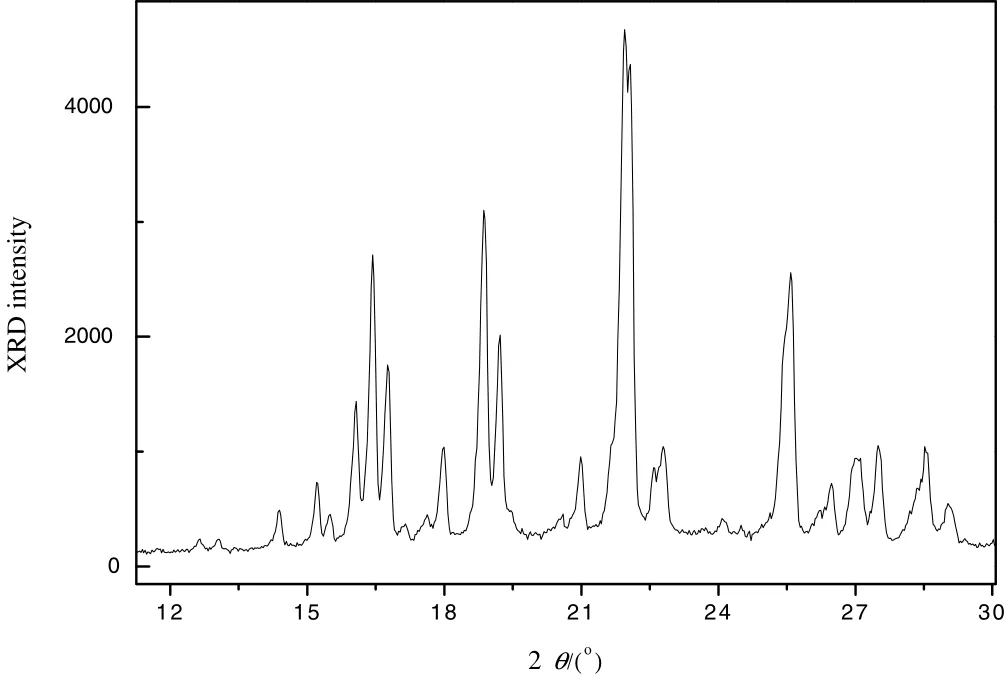
Fig.2.The XRD spectrum of the ionic compound of DBU/CH3OH/CO2.
The crystaldata and structure ofthe solid state DBU/CH3OH/CO2had been reported by crystallography[8].But the XRD spectrum(shown in Fig.2)of the solid state DBU/CH3OH/CO2was not found in the PDF data base.From the spectrum,one can see the compound has obvious X-ray diffraction peaks.The eight strong peaks were 16.0547°,16.4308°,16.7651°,18.8714°,19.2140°,21.9471°,22.0780°,and 25.5661°respectively.So it should have a certain melting/freezing point.
The decomposition point was detected with TGA(see Fig.3).The results show that the decomposition onset temperature of DBU/CH3OH/CO2ionic compound is 53°C,while its melting pointas reported in literature is close to 60°C[8].It means that the ionic compound decomposed before it melted.This property makes the ionic switch easy by decomposing DBU/CH3OH/CO2and releasing CO2at a mild temperature.

Fig.3.The TGA curve of the ionic compound of DBU/CH3OH/CO2.
3.3.Characterization by 1H NMR and 13C NMR spectroscopy
NMR spectra were collected to characterize DBU/CH3OH(1:1)solution and(DBU/CH3OH/CO2)crystal samples.The1H NMR and13C NMR spectra of samples are shown in Figs.4 and 5 and the spectral parameters are listed in Tables 2 and 3,respectively.The atoms of reactant and product are numbered according to Fig.6(a)and(b).
NMR results show that both DBU/CH3OH and DBU/CH3OH/CO2samples without any impurity substances.The hydrogen atom of hydroxyl of methanol was not found in1H NMR(Fig.4).It may be because the methanolhas a proton exchange with DMSO-d6.Forthe product,a broad peak at 8.787 ppm appeared.It belongs to the N-H proton of DBU,which shows DBU/CH3OH/CO2was created.Furthermore,from the1H NMR spectra(Fig.4(a)),the peak areas at each chemical shiftare in the proper ratios of the associated protons within the product,which suggests that the product is at high purity.From the13C NMR spectra,the position of the peaks supports this supposition.The spectrum of the DBU-CH3OH solution is a combination of the spectra of DBU and CH3OH.After bubbling CO2through the solution,however,a new carbon signalwas observed atδ=156.64,which is assigned to the carbonyl carbon of the formed carbonate.Moreover,the shift from 160.04 to 164.29 shown by the signals ofthe DBUcarbons close to the protonation site(C-7,down field shift)was expected.Similar NMR spectra of DBU alkylcarbonate salts(alkyl=ethyl,propyl,butyl,hexyl,octyl,decyl)had been reported by Jessop[8].Cao et al.detected their synthesized product by13C NMR and found more peaks than the carbon atom numbers in DBU/CH3OH/CO2ionic liquid[5].Those unaccounted for peaks indicate the likely presence of some impurities in their product.
3.4.FT-IR spectrum of DBU,DBU/CH3OH,and DBU/CH3OH/CO2 systems
In order to make sure the functional group of the product formed as described in Fig.1,the FT-IR spectrum of DBU,DBU/CH3OH,and DBU/CH3OH/CO2systems are compared in Fig.7.
The FT-IR spectra are shown for(a)DBU,(b)the mixture of DBUCH3OH(1:1),and the product(c)DBU/CH3OH/CO2(1:1:1).Compared to DBU,the spectrum of DBU/CH3OH exhibits an absorption peak at 1046 cm-1that belongs to the C-O vibration of CH3OH.But it is not found in the spectrum ofDBU/CH3OH/CO2.Thatindicates thatmethanol was completely associated with the ionic molecule.On the other hand,two bands at 1106 cm-1and 1207 cm-1are observed owing to the symmetric and asymmetric C-O-C stretching vibrations,respectively.DBU and DBU/CH3OH show a peak at 1614 cm-1,attributed to the C=N ring stretching vibration.After reacting with CO2the peak shifts and becomes weaker at1588 cm-1.There also appears a strong absorption at 1648 cm-1and a weak peak at 1325 cm-1which belong to C=O and C-O of the(O=C-O-)-R group stretching absorption bands,respectively.Similar absorption peak of DBU,CH3(CH2)5OH,and CO2was also reported[8],butdue to the overlap ofν(C=N)andν(C=O)in the same region,there is a strong band at 1648 cm-1.The bands at 2924 cm-1and 2852 cm-1are from the C-Hstretching vibration in the ring and from the alcohol and are therefore also seen even after bubbling CO2.The N-H stretching of DBU/CH3OH/CO2at 3117 cm-1and 3240 cm-1con firm protonation of the DBU,consistent with the1H NMR and13C NMR spectroscopy data.However,there is a broad band of DBU from 3375 cm-1to 3225 cm-1,which was caused by the trace water in the thin KBr disk prepared under high pressure in the IR testing process.Similar bands were observed in both spectra of the DBU/CH3OH and theDBU/CH3OH/CO2,but thebandof DBU/CH3OH was stronger and wider as expected.
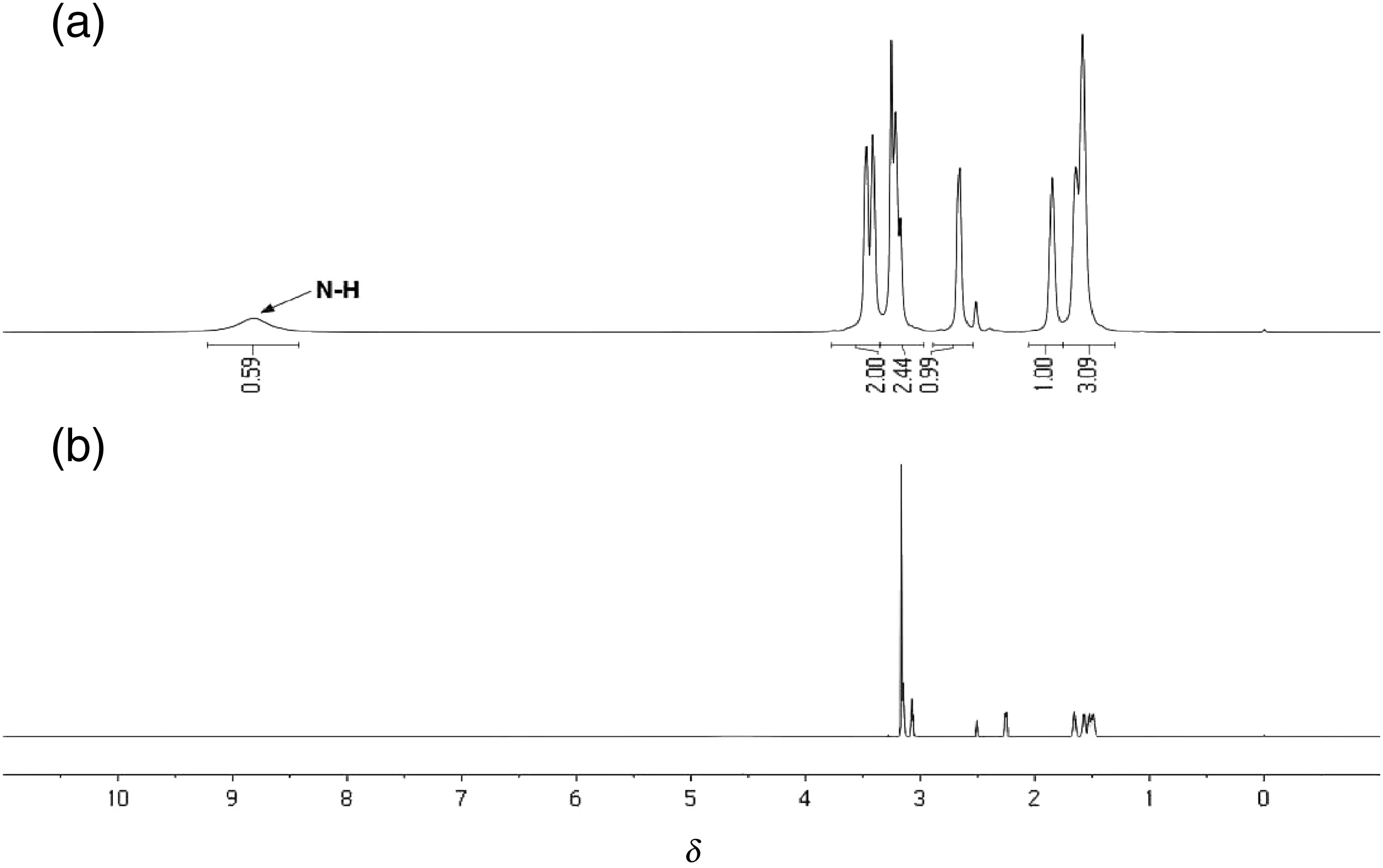
Fig.4.(a)The 1H NMR spectra of DBU/CH3OH/CO2(1:1:1),(b)DBU/CH3OH(1:1)using internal DMSO-d6 as a chemical sh ift reference.
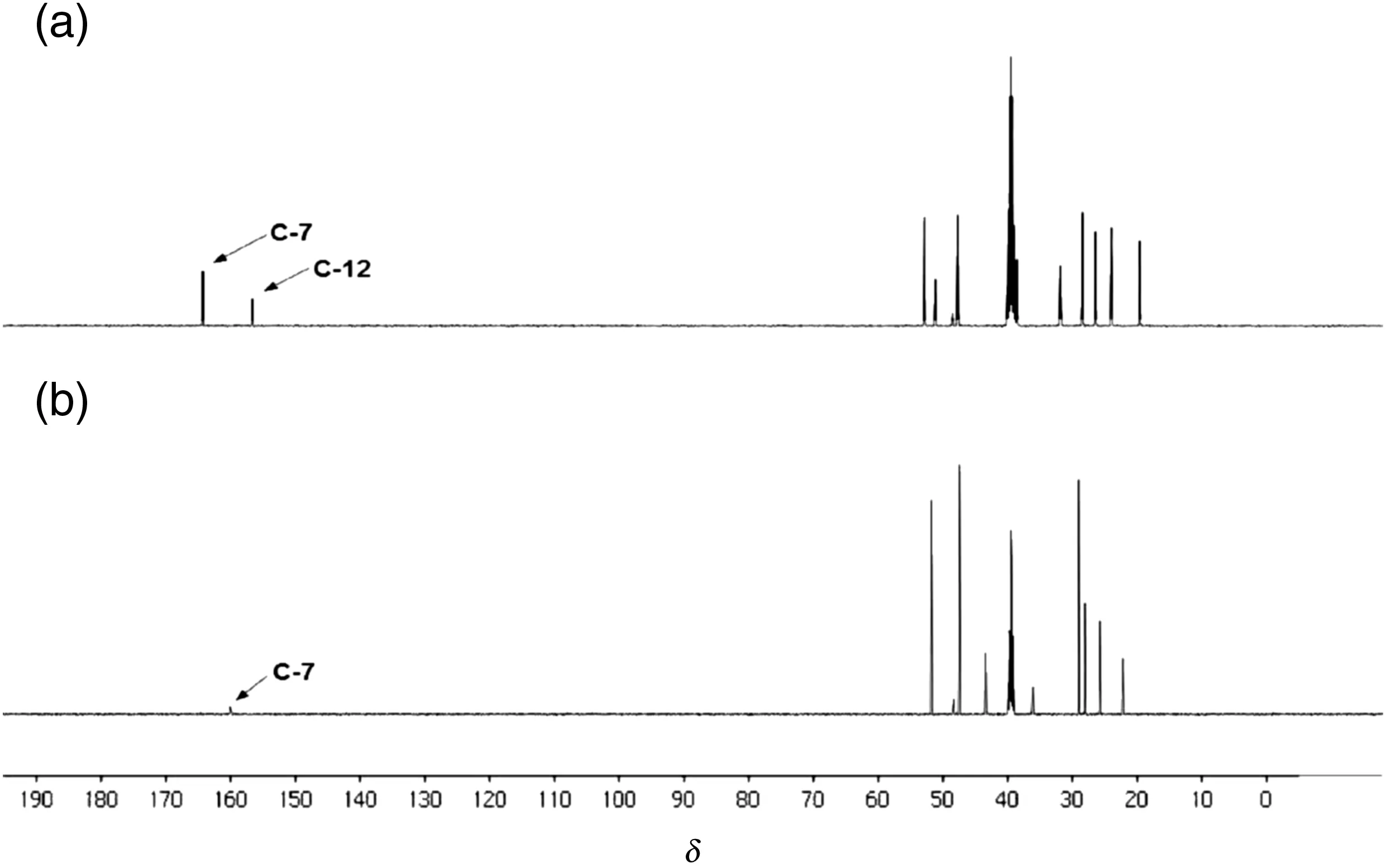
Fig.5.(a)The 13C NMR spectra of a neat sample of DBU/CH3OH/CO2(1:1:1),(b)DBU/CH3OH(1:1)using internal DMSO-d6 as a chemical shift reference.
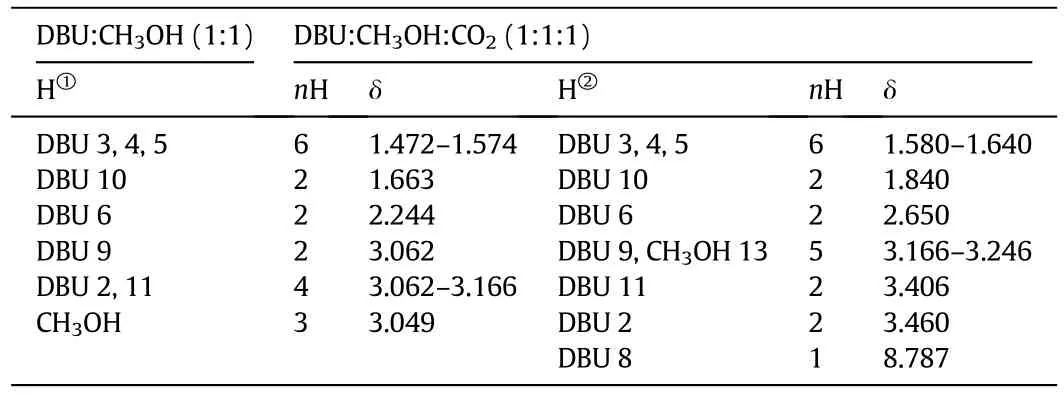
Table 2 1H NMR shifts and signal assignments in spectra of DBU/CH3OH(1:1)and DBU/CH3OH/CO2(1:1:1).Shifts are referred to an internal standard,DMSO-d6(δ=2.50)
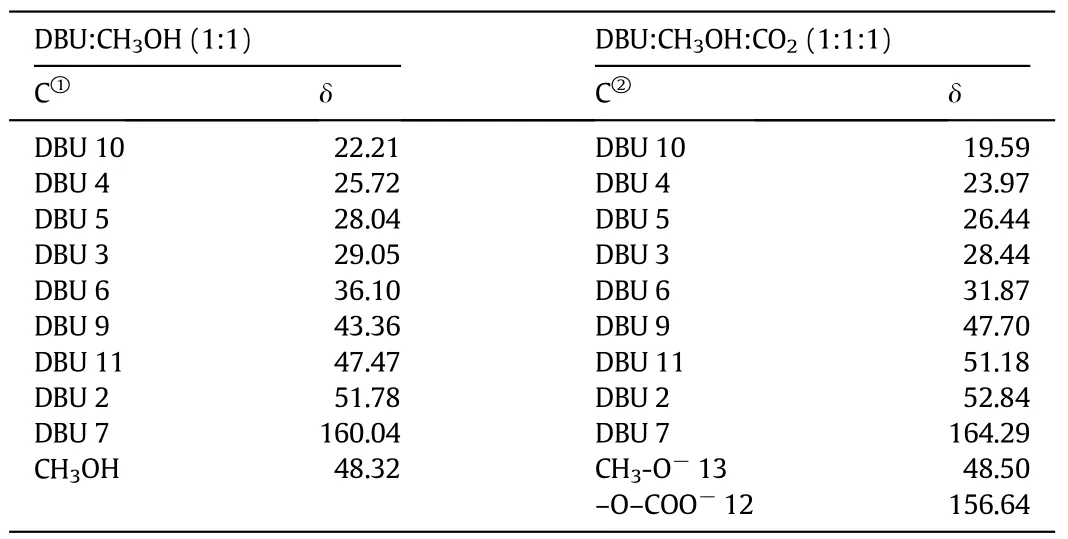
Table 3 13C NMR shifts and signal assignments in spectra of DBU/CH3OH(1:1)and DBU/CH3OH/CO2(1:1:1).Shifts are referred to an internal standard,DMSO-d6(δ=39.50)
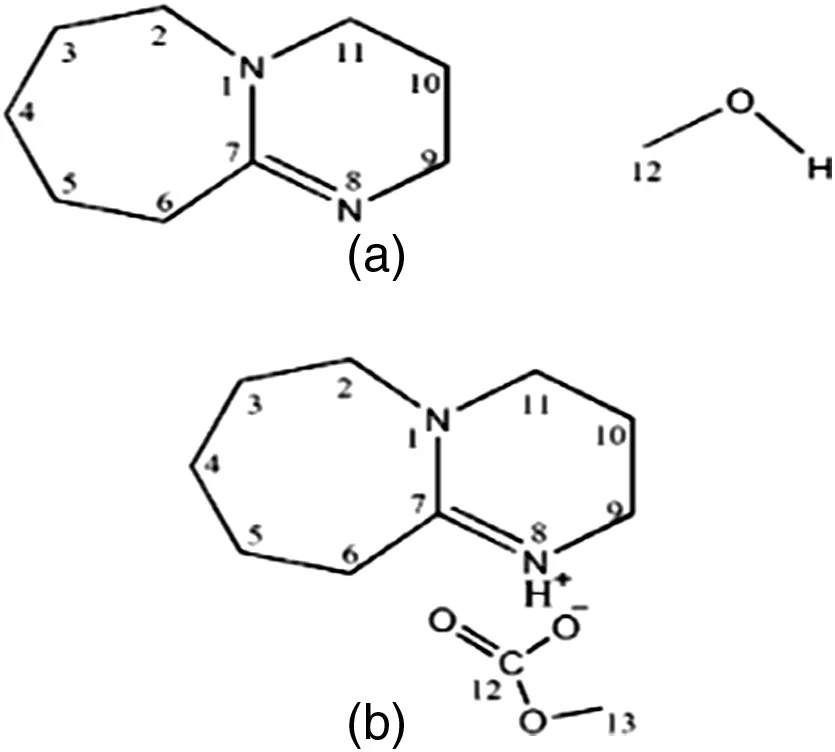
Fig.6.(a)Numbering of the carbon atoms in DBU and CH3OH.(b)Numbering of carbon atoms in the product of DBU,CH3OH,and CO2.

Fig.7.FT-IR spectra of(a)DBU,(b)DBU/CH3OH(1:1),and(c)the productofDBU/CH3OH/CO2.
3.5.The ionic change of DBU/CH3OH/CO2
Conductivity measurement was adopted to measure the ionic change for DBU/CH3OH/CO2,and the data are shown in Table 4.

Table 4 The conductivity of different pure substances and mixtures(30°C)
Ionic change which may greatly change its polarity is the key property for the switchable polarity solvent being used in extraction and separation applications.The conductivities of DBU(0 μs · cm-1)and CH3OH(5.823 μs · cm-1)at 30 °C are very low,and their 1:3 mixture is also low.However,after bubbling CO2,the ionic liquid of DBU/CH3OH/CO2in CH3OH has a high conductivity of 5163 μs · cm-1.The literature also reported the great conductivity and polarity change of a neat,equimolar DBU,and 1-hexanol mixture from neutral to ionic,andfromnonpolartopolaratroomtemperaturewhileCO2wasbubbled through the liquid[8].This result indicates the change from nonionic(low conductivity)to ionic(high conductivity),and CO2can be used as a trigger for switching the DBU from molecular to ionic form.N2can switch the ionic form back to the molecular compound.
3.6.The proposed reaction of DBU,CH3OH,and CO2
Since the conductivity of the equal volume mixture of DBU and CH3OH is 330.0 μs · cm-1,which is much higher than the conductivity ofeitherDBU(0μs·cm-1)orCH3OH(5.823μs·cm-1),a2-stepchemical reaction sequence as shown in Fig.8 is proposed.
According to Fig.8,DBU and CH3OH are in equilibrium with DBUH+and CH3O-,which is consistent withthe literature of Medina et al.[11]and Li et al.[12].Medina et al.described DBU proton extraction from H2O and Li claimed DBU obtained a proton from sulfonyl semicarbazide.After bubbling CO2through the mixture of DBU and CH3OH(1:3),the conductivity was 5163 μs · cm-1,indicating a much higher ionic content than the DBU/CH3OH mixture.Therefore,the second step of Fig.8 shows the formation of the final ionic product.A similar reaction was proposed by Mikkola et al.[2]between DBU,glycerol,and CO2and Liu et al.[13],between DBU,fluoroalcohols,and CO2.

Fig.8.Proposed reaction for the formation of[DBUH]+[CH3OOCO]-.
4.Conclusions
1:1:1 of DBU/CH3OH/CO2was prepared in excess CH3OH and the solid ionic compound was obtained by removing the excess methanol in CO2atmosphere.NMR spectra show that DBU,CH3OH,and CO2reacted in stoichiometric ratio;FT-IR spectra indicated that N-H,C-O,and C=O bonds formed in the DBU/CH3OH/CO2compound;TGA curve detected its decomposition onset temperature being 53°C.Conductivity measurements con firmed the ionic switch process of the switchable compound during the reaction process.
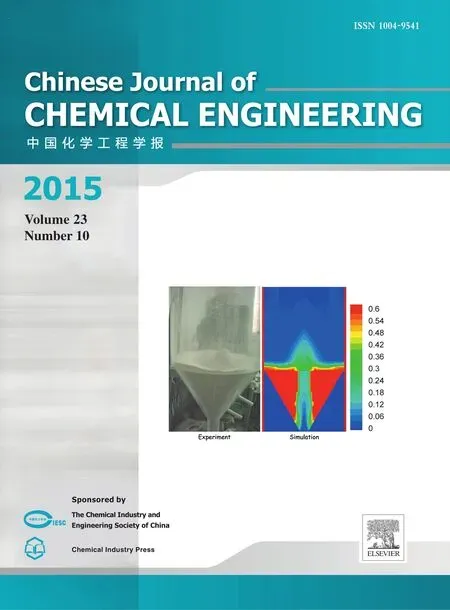 Chinese Journal of Chemical Engineering2015年10期
Chinese Journal of Chemical Engineering2015年10期
- Chinese Journal of Chemical Engineering的其它文章
- Preparation and simulation of a taro flavor☆
- Preparation and characterization of monodisperse zirconia spherical nanometer powder via lamellar liquid crystal template method
- Effect of PSA tin plating process on trace lead in tin coating☆
- Biological treatment of high wastewater using an ammonia-tolerant photosynthetic bacteria strain(ISASWR2014)☆
- Adsorption and degradation of nor floxacin by a novel molecular imprinting magnetic Fenton-like catalyst☆
- TG-FTIR analysis of pyrolusite reduction by major biomass components☆
